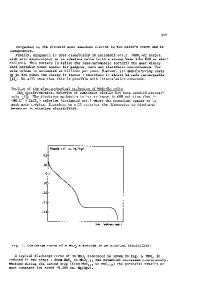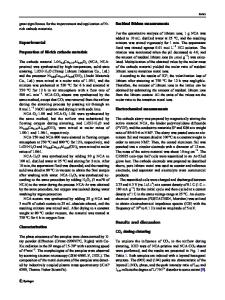Functionalized Carbonaceous Materials as Cathode for Lithium-Ion Batteries
- PDF / 314,750 Bytes
- 6 Pages / 432 x 648 pts Page_size
- 84 Downloads / 349 Views
Functionalized Carbonaceous Materials as Cathode for Lithium-Ion Batteries Hai Zhong,1 Chunhua Wang,1,2 Zhibin Xu,1 Fei Ding1,* , Xingjiang Liu1 1 National Key Laboratory of Science and Technology on Power Source, Tianjin Institute of Power Source, Tianjin, 300384, P. R. China 2 College of Chemistry and Molecular Sciences, Wuhan University, Wuhan, 430072, P. R. China ABSTRACT Activated carbon materials are integrated into functionalization of graphene nano-sheets to serve as a high-power lithium cathode. The electrochemical performance shows that the composite displays the highest reversible capacity (c. 170 mAh g-1) comparing with functionalized graphene and activated carbon. Also, approximately 92% of its capacity can be retained after 4,000 cycles at a current of 1 A g-1. Moreover, the composite exhibits an excellent rate performance, a reversible capacity of 90 mAh g-1 even at 6 A g-1, which corresponds to the power density of 15.2 kW kg-1 and energy density of 227 Wh kg-1, respectively. The high performance of this composite can be attributed to the fact that the activated carbon particles not only reduce the graphene sheet stacking thus making it easier for ions to diffuse, but also act as an ion storage buffer against accelerating electron transfer. INTRODUCTION Lithium-ion batteries (LIBs) are promising candidates for electric vehicle, because of their high energy density. However, poor rate performance of current commercial LIBs limits their practical application in electric vehicle due to the lower power density and short cycle life.[1,2] Thus, it is necessary to develop new, safe, materials with excellent rate performance and a longterm cycling life. One approach to resolving the aforementioned challenge is to adopt fast surface electrode reactions while maintaining a high energy density. The fast pseudo-capacitive surface reaction (Faradaic redox reaction) enables enhanced high-power performance since the kinetic limitation imposed by the extremely slow solid state diffusion could be avoided. Among many of carbonaceous materials, the functionalized graphene (FGp)[3,4] has demonstrated that enabling this fast surface reaction could lead to exceptionally high Li storage capability. The reaction sites are carbonyl and carboxylic acid functional groups, its reduction and oxidation are accompanied by the association and disassociation of Li+ ions with oxygen, which is similar to that in organic carbonyl compounds.[5] However, Ajayan[6] shows that the unfavorable limit, with all graphene layers parallel to the current collectors, in the case of a stacked (conventional) geometry, arises where the electrochemical surface area is incompletely utilized because some regions are inaccessible to the electrolyte ions. On the other hand, activated carbon, commonly used for energy storage devices, shows an ultra-fast charge/discharge process, due to physical ion adsorption and de-adsorption on the pore surface. ,[7,8] Even though it provides a high power density, the energy density is not satisfactory. Herein, we integr
Data Loading...











